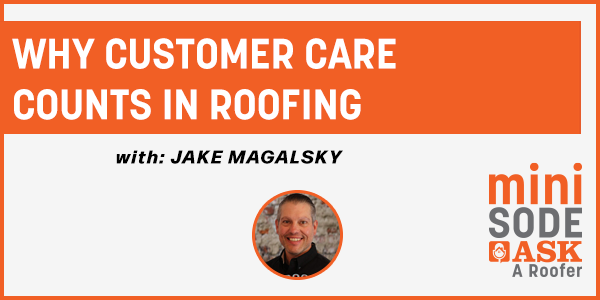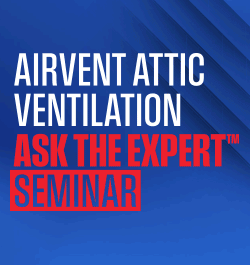Tony Vizzi - Why Ventilation Matters More Than Ever - PODCAST TRANSCRIPTION
May 15, 2023 at 6:00 p.m.Editor's note: The following is the transcript of a live interview with Tony Vizzi of Quarrix. You can read the interview below or listen to the podcast.
Speaker 1: Welcome to Roofing Road Trips with Heidi. Explore the roofing industry through the eyes of a long-term professional within the trade. Listen for insights, interviews, and exciting news in the roofing industry today.
Heidi J. Ellsworth: Hello and welcome to another Roofing Road Trips from Roofers Coffee Shop. My name is Heidi Ellsworth, and I am here today with Tony Vizzi to talk about ventilation. Yep. Our favorite topic in roofing, ventilation and how important it is. Tony, thank you so much for being here today.
Tony Vizzi: Heidi, thanks for having me. I'm really excited to join you.
Heidi J. Ellsworth: I've been really looking forward to this, and I know I'm sure some people on roofing are like, "I know everything there is to know about ventilation," but not really because we're seeing it all the time. Incorrect ventilation, different regions of the country. So, I'm excited to talk to you about that. But first, let's go have you introduce yourself and tell us a little bit about Correx.
Tony Vizzi: My name is Tony Vizzi. I'm the regional sales manager for the East coast. I started my career in remodeling, specializing in both roofing, inciting, sales and installation. As my career path changed, it took me away from the installation channel and into corporate side of the industry, particularly into sales management, and I would say product [inaudible 00:01:28]. But the common theme there is that my career's been residential, exterior products.
Heidi J. Ellsworth: Awesome. Very cool. So, you have a lot of experience.
Tony Vizzi: Yeah. I'm not going to share how many years, [inaudible 00:01:42].
Heidi J. Ellsworth: Can you tell us a little bit about Correx, and the company, and what you all are doing leading the way on ventilation.
Tony Vizzi: In our core, Correx is a ventilation focus company. We've built a quarry or a basket of products that focuses on attic protection, roof protection, and wall protection products. These are solutions that are sold into the residential and multifamily sectors. Ultimately, our customer is the professional roofing contractor, and in many cases the do it yourselfer. They purchase our products primarily through multiple channels, but one step distribution, two-step distribution, and your local lumber yard.
Heidi J. Ellsworth: Right, okay. And the heart is ventilation, but you also do a number of types of products.
Tony Vizzi: We do. And so, as I mentioned, we have three categories that we go out into the marketplace and discuss with different customers hoping that we can find the right solution for each. And so, I mentioned attic protection first and foremost, because that is the core nature of our business. That's how we grew up in this industry as ventilation experts. But, we've expanded that into roof protection products such as roof fence, a few other accessory items, like the smart plug that patch a hole on the roof. And then our composite roofing tile, which is a complete system with a double barrel tile that's used in a Spanish or Mediterranean architectural set.
Heidi J. Ellsworth: It's a very cool product.
Tony Vizzi: Yeah. It is. And I know maybe into the future we might expand on that bit.
Heidi J. Ellsworth: I think so.
Tony Vizzi: And then, third, are wall protection products. What we are beginning to see out in the marketplace is that these types of products that allow the wall to breathe behind the exterior cladding are just as important as the products that we sell as solutions for the rooftop. So, there's some common theme there that these are all exterior products, and sold primarily to the professional remodeling segment of our customer base.
Heidi J. Ellsworth: So, let's talk ventilation a little bit. Why is ventilation even more important today? Or why does it matter more than I think it even has in the past? What are some of the indicators out there that are just making ventilation even more important?
Tony Vizzi: Yeah, that's a great question though. I'm glad you asked. There are several factors, some I mentioned. The first is a tighter building envelope. As innovation has progressed, we have window products and exterior claddings, and synthetic underlays, and more, which cumulatively reduce air movement from the interior of the home. And so, that's, to me, the primary or major factor. Another factor is a focus on energy efficiencies.
Heidi J. Ellsworth: Yes.
Tony Vizzi: For all of us who pay monthly gas and electric bills, we see the rising costs in finding solutions that lessen those costs. It's critical to our budgets. The planet has a finite supply of energy, and so conserving it where we can makes sense for the globe.
Heidi J. Ellsworth: I agree. Things are changing building codes, like you said, how the homes and buildings are being sealed up. And so, a lot of times there's a lot of myths or old ways of thinking about ventilation that maybe just aren't true today, or maybe they never were, but definitely not today. So, what are some of the top myths around ventilation?
Tony Vizzi: Yeah. So, I would put them, not necessarily in order of importance, but the first that comes to mind is more ventilation is better. Based on my experience in according to both building science and codes, what's best is a balance system built around the principles of convection. Convection is kind of when the temperature differences make particles shift around in the air. And in our homes, convection current makes warm air rise, and cold air sink to the floor as the warm air rises. I should say warm air rises because it's more dense than the cold air. Consequently, when the warm air rises and gets trapped, it causes problems. The way a roof ventilation system works is simple. It uses a series of vents to let warm air out. We call that exhaust. And a series of vents to let fresh or cool air in, and we call this intake. And the best system is a balance of 50% intake and 50% exhaust. So, that myth of more ventilation is better, I would say that best practice would be a balanced system.
Heidi J. Ellsworth: Balanced system. Okay, that makes sense.
Tony Vizzi: Yeah. And then any questions about that?
Heidi J. Ellsworth: No, that makes sense to me.
Tony Vizzi: I'll go on with another big myth, and that's gable vents. Gable vents typically have a static value to your home, but you need mother nature's support with wind to make it work. And that wind needs to be in the proper direction. At that point, those natural principles of convection don't apply. You're saddled with which way the wind blows, and that's just not the best type of system. So as far as a myth, I would say that it's untrue.
Heidi J. Ellsworth: Okay.
Tony Vizzi: And then I would say that maybe the third, and there's more, but the third is that ventilation matters most in hotter climates. I would say that ventilation matters in all climates. And the primary purpose for ventilation is to move stagnant air and [inaudible 00:08:46] moisture. What the average homeowner doesn't realize is we produce up to six gallons of water vapor per day.
Heidi J. Ellsworth: Wow.
Tony Vizzi: [inaudible 00:08:56]. Think about showers, and washing machines, and dishwashers, and electronics, and so on and so forth. So, every home independent of climate has to have a system in place to remove that moisture from our living space. And the escape hatches for that moisture is through our walls and through our ceilings. So, every climate worldwide really needs an adequate ventilation system in place.
Heidi J. Ellsworth: I live in the Pacific Northwest, and that last myth really hits home, because they'll say it just needs to be in warm climates, but that's not true. We have so much moisture despite the six gallons that we provide on our own. We also have so much rain all the time, and everything's a little musty and wet. And so, yeah, you really need to know your regions, and you need to know what is necessary within that region. But, like you said, everywhere needs it. Every home needs ventilation. Let's talk about that a little bit more, because there have been changes to the building codes around this. So, what are some of the recent revisions or items that contractors should be aware of when it comes to ventilation and building codes?
Tony Vizzi: Tricky question.
Heidi J. Ellsworth: Good.
Tony Vizzi: There's an international code and sometimes municipal codes. And so, that's why I say it's a little bit tricky, but let's stick to international residential code-
Heidi J. Ellsworth: Okay.
Tony Vizzi: ... And then we can go from there. The current IRC requirement states that for every 150 square feet of attic space, you'll need one square foot of net free area. So, it's simple calculation. We-
Heidi J. Ellsworth: Right.
Tony Vizzi: ... one over 150. As I mentioned earlier, this one square foot should be balanced. 50% of that should be on the intake and the other 50% as exhaust. Now, there are some provisions in the current code that will allow you to get to a ratio of one in 300. It's a bit complicated, and it's zone driven, yet in certain zones it's applicable. And basically what has to happen is you would need a vapor retardant on the warm side of your ceiling.
Heidi J. Ellsworth: Okay.
Tony Vizzi: And so, in a remodeling scenario, very difficult. In a new construction scenario, quite possible. And so, it changes their ratio from 150 to one in 300. And then I would also say that in that second case scenario of one in 300, it begins getting challenging to get the right balance. Most remodeling contractors are going to fall inside of that one in 150 ratio that the IRC requires. And again, as I prefaced earlier that this is a... I know you didn't mean it to be a trick question, but municipalities are all a little bit different. You live in a moist climate, and then we go to the complete diagonal down into a warm climate like the Southeast, and it's a little bit different. So, the codes are guidelines that municipalities typically follow.
Heidi J. Ellsworth: Right. And it's important to know your local building codes, because it does change. For the contractors who are listening out there and they're like, "Okay, I need to figure out making sure that..." Maybe they haven't been doing ventilation and they need to. How do you evaluate existing ventilation and conduct a ventilation audit?
Tony Vizzi: Simply put, an audit is a calculation to determine the adequate amount of ventilation to adhere to the building codes. And we just talked about what that ratio is. And so, the professional roofing contractor can easily do an audit by understanding first that free area that's needed, that ratio. After sourcing products he chooses, he'll find that each of those products from different manufacturers come with rated NFAs, which is net free area, through those different products. Now these products are third party verified, and adheres to strict industry standards. So, very reliable. Armed with this information, the professional is able to calculate utilizing this balance system approach, how much exhaust is needed at or near the ridge area, and how much intake is needed located at or near the eave. The principle of convection is now naturally replaced as heat rises through that exhaust, cooler fresh air is drawn in through the eave or the intake. So, very natural easy system, no mechanical devices required, which require additional costs to us as homeowners. So, just a very simple system, this concept of conduction.
Heidi J. Ellsworth: The contractors, once they understand that, they have to communicate it to homeowners or building owners, what's some of your advice or tips on how to bring this down to a point where it's easy to explain and it's a natural part of your sales process?
Tony Vizzi: That goes back to part of my past in training. The way I was trained, and how I've communicated that in training sessions is, you do a walkabout or an assessment around the home that is visual. And then you do want to have conversations with the homeowner to understand better has the home or building had a history of issues? Is there anything inside that would lead to higher humidity levels?
Simple questions, added appliances, for instance, could be on that list. History of issues could be water damn or a moisture issue within the home. Most importantly would be a visual inspection of the intake in particular. And a lot of times that requires taking a look inside that attic. So, crawling up inside there to see if the eave, or stop ventilation, or the intake is blocked or open. So, that's really critical in this assessment process. And the professional typically will look at different roof elevations, understanding where heat would rise to its highest point. And so, as he does this assessment, he needs to communicate what he sees from a professional standpoint and have solutions ready for that homeowner and discuss those solutions. And I think that interaction validates his knowledge and his professionalism within the industry.
Heidi J. Ellsworth: That's great advice. And it really leads into actually one of my last questions. How would you recommend for a roofing contractor to get the ventilation mindset for all the employees so that whether they're taking the phone call at the front desk, or they're billing, or they're on the roof, or they're selling, they have this thought of the importance of ventilation for the health of the building in the roof?
Tony Vizzi: Yeah. That's a cultural shift-
Heidi J. Ellsworth: Yeah.
Tony Vizzi: ... Internally. Right? And so, we kind of discussed earlier some of the benefits of good ventilation and whether it's a fresh, clean air movement of stagnant air, longevity of different materials such as your roofing materials and [inaudible 00:17:54]. And so, as employees begin to become more knowledgeable as to the reasons why it's important for good ventilation, they can then communicate differently internally. And then, of course, once that culture shift occurs, that becomes common nomenclature within a organization. And I would also say that it could be a separating factor in the sales process. More recently, I was on a sales call doing training with a company who didn't see the value before our training as they did afterwards. And they are beginning to implement that into their sales in home, and feel that that's going to be a separating factor in their presentation.
Heidi J. Ellsworth: Yeah.
Tony Vizzi: Just becoming more knowledgeable and that knowledge resonates with us consumers.
Heidi J. Ellsworth: I think it really does. And I think it's so important. I will say that we've done some with you, with Correx, in the past. We've done some great ventilation webinars and podcasts, and now with this one. I think this is a great way to, he help employees learn more, watch the webinars or the lunch and learns, or listen to the podcast. And like you said, it's a cultural shift, making sure that everyone is thinking that same direction. Tony, thank you. Great information. I so appreciate your time.
Tony Vizzi: Thanks Heidi. And I appreciate yours, and look forward to another opportunity to be with you.
Heidi J. Ellsworth: We will do it again, let me tell you. And like I said, we have all kinds of great information from Correx on the Roofers Coffee Shop in their directory, we have a number of webinars, podcasts, articles, everything you need to help educate yourself, your company, and your customers. So, I'm going to say one last time, thank you, Tony, and we'll see you next time.
And I'm going to say thank you to all of you for being here on this podcast. Thank you for visiting these directories, reading the articles, really taking this information and sharing it in your company. And be sure to listen to all the podcasts, which are under the RLW, Read Listen Watch section of the website, under Roofing Road Trips, or on your favorite podcast channel. Be sure to subscribe and set those notifications so you don't miss a single episode. And we'll be seeing you next time on Roofing Road Trips.
Speaker 1: Make sure to subscribe to our channel and leave a review. Thanks for listening. This has been Roofing Road Trips with Heidi from the rooferscoffeeshop.com.
Recommended For You

Joel Stanley - Answering the Call of Innovation - PODCAST TRANSCRIPT
Read More ...
Heidi and Vickie Show- An Insider's View on Associations and Trade Shows- PODCAST TRANSCRIPTION
Read More ...
Why Customer Care Counts in Roofing - PODCAST TRANSCRIPT
Read More ...

















Comments
Leave a Reply
Have an account? Login to leave a comment!
Sign In